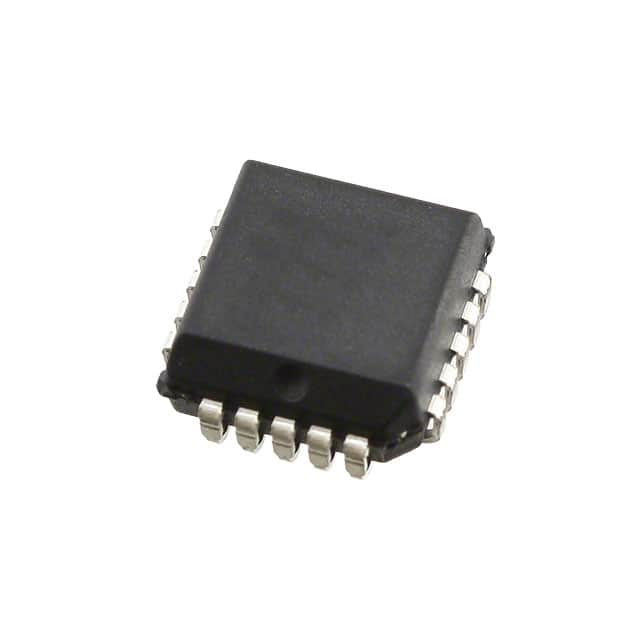Xem thông số kỹ thuật để biết chi tiết sản phẩm.

XC18V01PC20I
Product Overview
- Category: Programmable Logic Device (PLD)
- Use: Integrated circuit used for digital logic functions
- Characteristics:
- High-speed operation
- Low power consumption
- Non-volatile memory
- Package: 20-pin plastic leaded chip carrier (PLCC)
- Essence: XC18V01PC20I is a versatile PLD that offers programmable logic capabilities with non-volatile memory, allowing for reconfiguration of digital logic functions.
- Packaging/Quantity: Available in reels or tubes, quantity varies based on customer requirements.
Specifications
- Technology: CMOS
- Operating Voltage: 3.3V
- Speed Grade: 20ns
- Memory Capacity: 1 Megabit
- I/O Pins: 18
- Temperature Range: -40°C to +85°C
- Programming Method: In-system programmable (ISP) via JTAG interface
Pin Configuration
The XC18V01PC20I has a total of 20 pins, each serving a specific purpose. The pin configuration is as follows:
- VCC - Power supply voltage
- GND - Ground reference
- OE - Output enable
- CE - Chip enable
- A0-A16 - Address inputs
- DQ0-DQ7 - Data input/output
- WE - Write enable
- NC - No connection
- NC - No connection
- NC - No connection
- NC - No connection
- NC - No connection
- NC - No connection
- NC - No connection
- NC - No connection
- NC - No connection
- NC - No connection
- NC - No connection
- NC - No connection
- NC - No connection
Functional Features
- High-speed operation allows for efficient execution of digital logic functions.
- Non-volatile memory retains programmed logic even when power is removed.
- Low power consumption ensures energy efficiency.
- In-system programmability enables easy reconfiguration of logic functions.
Advantages and Disadvantages
Advantages: - Versatile and flexible programmable logic capabilities - Non-volatile memory ensures retention of programmed logic - High-speed operation for efficient performance - Low power consumption for energy efficiency
Disadvantages: - Limited memory capacity compared to some other PLDs - Programming process requires specialized equipment and knowledge
Working Principles
The XC18V01PC20I utilizes CMOS technology to implement programmable logic functions. It consists of a matrix of configurable logic blocks (CLBs) interconnected through programmable interconnects. The device can be programmed using the JTAG interface, allowing users to define the desired logic functions by configuring the CLBs and interconnects. Once programmed, the logic functions are stored in non-volatile memory, ensuring their retention even when power is removed.
Application Field Plans
The XC18V01PC20I finds applications in various fields, including:
- Industrial automation: Used for control and monitoring systems in manufacturing processes.
- Telecommunications: Employed in network infrastructure equipment for signal processing and protocol handling.
- Automotive electronics: Integrated into automotive control units for functions such as engine management and safety systems.
- Consumer electronics: Utilized in devices like gaming consoles and home appliances for implementing custom logic functions.
Alternative Models
There are several alternative models available that offer similar functionality to the XC18V01PC20I. Some notable alternatives include:
- XC18V02PC20I: Offers double the memory capacity with 2 Megabits.
- XC18V04PC20I: Provides quadruple the memory capacity with 4 Megabits.
- XC18V08PC20I: Offers eight times the memory capacity with 8 Megabits.
These alternative models cater to different memory requirements while maintaining similar features and pin configurations.
In conclusion, the XC18V01PC20I is a versatile PLD that combines programmable logic capabilities with non-volatile memory. Its high-speed operation, low power consumption, and in-system programmability make it suitable for various applications in different fields. While it has some limitations in terms of memory capacity, there are alternative models available to meet specific requirements.
Liệt kê 10 câu hỏi và câu trả lời thường gặp liên quan đến ứng dụng XC18V01PC20I trong giải pháp kỹ thuật
Sure! Here are 10 common questions and answers related to the application of XC18V01PC20I in technical solutions:
Q: What is XC18V01PC20I? A: XC18V01PC20I is a specific model of programmable logic device (PLD) manufactured by Xilinx.
Q: What are the key features of XC18V01PC20I? A: XC18V01PC20I has a capacity of 1Mb, operates at a voltage of 3.3V, and offers 20ns access time.
Q: What is the typical application of XC18V01PC20I? A: XC18V01PC20I is commonly used in various digital systems, such as telecommunications equipment, industrial control systems, and automotive electronics.
Q: How does XC18V01PC20I differ from other PLDs? A: XC18V01PC20I is a non-volatile PLD, meaning that it retains its programmed configuration even when power is removed.
Q: Can XC18V01PC20I be reprogrammed after initial programming? A: No, XC18V01PC20I is a one-time programmable (OTP) device, which means it cannot be reprogrammed once it has been configured.
Q: What programming tools are required for XC18V01PC20I? A: XC18V01PC20I can be programmed using Xilinx's iMPACT software, which requires a compatible programming cable and a host computer.
Q: Is XC18V01PC20I suitable for high-speed applications? A: Yes, XC18V01PC20I has a fast access time of 20ns, making it suitable for high-speed digital systems.
Q: Can XC18V01PC20I interface with other components or devices? A: Yes, XC18V01PC20I can be easily interfaced with other digital components using standard logic levels and protocols.
Q: What is the operating temperature range of XC18V01PC20I? A: XC18V01PC20I is designed to operate within a temperature range of -40°C to 85°C.
Q: Are there any specific design considerations when using XC18V01PC20I? A: It is important to ensure proper power supply decoupling, signal integrity, and adhere to recommended design guidelines provided by Xilinx in the datasheet.
Please note that these answers are general and may vary depending on the specific requirements and application of XC18V01PC20I in a technical solution.

